Historians tell us
that the Industrial Age began with the invention of the steam engine
in the 1840s. But really it began a century earlier with the
founding of the iron industry in America. Iron became the basic
material of industry, eventually helping to build the factories and
equipment to make it run.
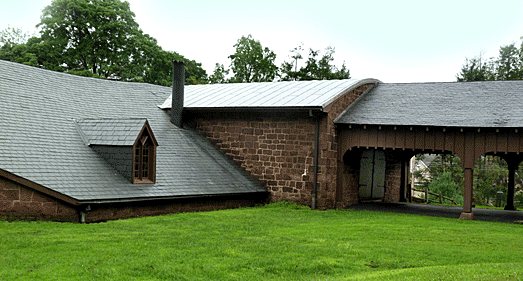
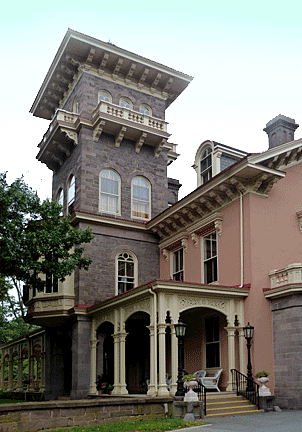 The
only surviving intact charcoal cold blast furnace in the Western
Hemisphere, the Cornwall Iron Furnace in Cornwall, Pennsylvania, was
the heart of a vast industrial plantation for over 140 years. It and
other iron furnaces dotted the Pennsylvania countryside in the 18th
and 19th centuries. Around them grew villages, with artisans' shops,
stores, schools, churches, and the home of a wealthy ironmaster. The
areas around these furnaces supplied the iron ore, limestone, and
wood for charcoal, .all of the raw materials necessary for the
smelting process. At its peak, the Cornwall iron plantation
consisted of about 10,000 acres.
The
only surviving intact charcoal cold blast furnace in the Western
Hemisphere, the Cornwall Iron Furnace in Cornwall, Pennsylvania, was
the heart of a vast industrial plantation for over 140 years. It and
other iron furnaces dotted the Pennsylvania countryside in the 18th
and 19th centuries. Around them grew villages, with artisans' shops,
stores, schools, churches, and the home of a wealthy ironmaster. The
areas around these furnaces supplied the iron ore, limestone, and
wood for charcoal, .all of the raw materials necessary for the
smelting process. At its peak, the Cornwall iron plantation
consisted of about 10,000 acres.
The Early Years
In the 1730s, Peter Grubb, a stone mason, began mining nearby. In
1742, he established the furnace, naming it Cornwall after his
father's birthplace in England, which remained in operation until
1883. Although the British Parliament attempted in 1750 to restrict
production of iron in the Colonies, the output continued to rise.
Pennsylvania was the leading producer, smelting one-seventh of the
world's iron.
By the 1850s, small villages, housing miners and workers, grew up
around the furnace. The buildings were simple structures of stone
and brick.
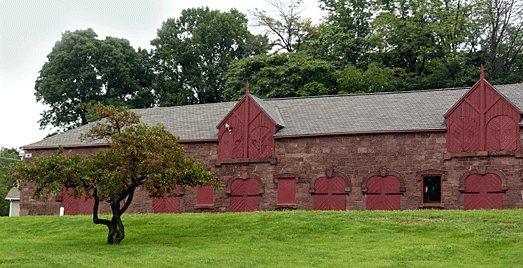
When Peter died in 1751, the property passed to his sons, Curttis
and Peter. By 1798, the Grubb family said out to Robert E Coleman.
He was so successful that he became one of Pennsylvania's first
millionaires.
The Role of Iron in Everyday
Colonial Life
Blacksmiths have long fashioned wrought-iron products. At the time
of American settlement, most tools and many household items in
Europe were made at least partially of iron. Emigrants to Colonial
America sacrificed many comforts but were unwilling to do without
iron. Since Native Americans produced no iron and importing iron and
iron products from Europe was prohibitively expensive, early
settlers had a powerful incentive to master ironmaking.
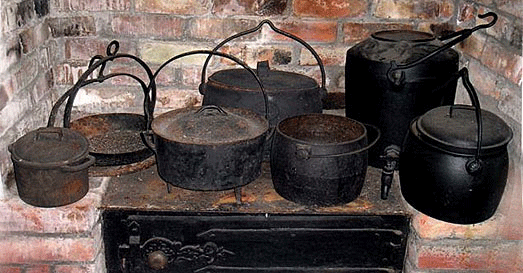
Though the techniques of ironmaking have been refined over many
centuries, the process has remained essentially unchanged.
Ironmakers used intense heat to separate the iron in iron ore from
impurities, the waste is discarded, and useful products are
fabricated with the remaining iron. Overall, ironmaking is an
arduous process. Feeding a blast furnace is like feeding a noisy,
fire-breathing dragon, surrounded by flames, smoke, ashes, sparks,
and soot, and whose main product by volume is carbon monoxide.
Ironmaking requires enormous amounts of fuel to bum hot enough to
melt the iron ore, or at least soften it enough so the iron can be
isolated by repeated hammering. Limestone is the flux. And finally,
there needs to be a way to apply large amounts of oxygen needed for
the furnace fire to burn hot enough. The entire smelting process
required a large number of skilled and unskilled workers.
The Ironmaking Process
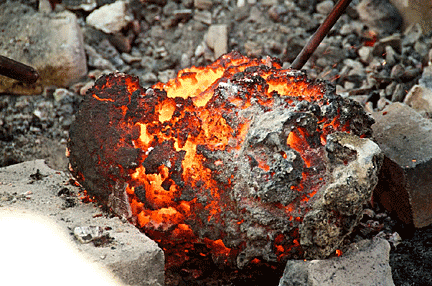 The
first step in smelting iron is to remove oxygen from the iron by
direct induction. This took place in a bloomery, so named for the
bloom, the mass of iron as it lay in the coals.
The
first step in smelting iron is to remove oxygen from the iron by
direct induction. This took place in a bloomery, so named for the
bloom, the mass of iron as it lay in the coals.
Cornwall smelted its iron ore with a blast furnace and indirect
reduction in high heat. While it’s not necessary to melt the rocks
to make wrought iron in a bloomery, it is necessary to melt the
rocks to make cast iron in a blast furnace. This was a flat-topped,
truncated, hollow pyramid, usually 25 to 35 feet high and
constructed in three layers—a stonework stack, a sandstone or
firebrick lining, and a layer of rubble and other materials between
the stack and the lining that provided insulation and allowed for
expansion and contraction.
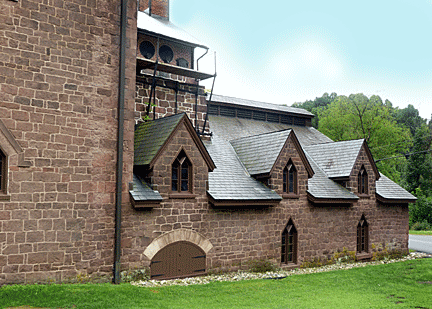 Iron
workers fed, or charged, the blast furnace at regular intervals with
charcoal, iron ore, and limestone placed into its mouth. Charging by
buggy or basket continued day and night for as long as the furnace
was in blast. The massive stonework of the furnace structure
provided containment for an inferno of burning charcoal and
functioned as support for the hollow, bottle-shaped lining of the
furnace, where the iron was actually separated from the ore.
Iron
workers fed, or charged, the blast furnace at regular intervals with
charcoal, iron ore, and limestone placed into its mouth. Charging by
buggy or basket continued day and night for as long as the furnace
was in blast. The massive stonework of the furnace structure
provided containment for an inferno of burning charcoal and
functioned as support for the hollow, bottle-shaped lining of the
furnace, where the iron was actually separated from the ore.
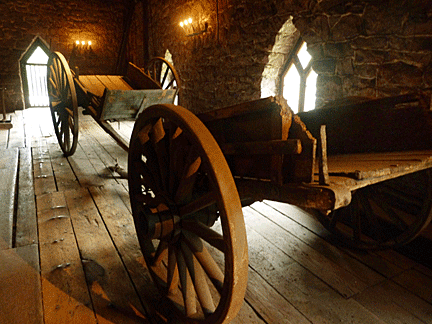 The
shape of the furnace lining was critical to its operation. Downward
from the mouth, the lining widened to about nine feet until it
reached its center, the bosh, where the rocks would melt. A funnel
formed below the bosh, where the lining wall sloped inward to about
four feet. This shape provided necessary support for the burning
mixture so that the blast could pass through unhampered. Hot, molten
rock material trickled down and funneled into the crucible which
contained it, with heavy iron on the bottom and impurities forming a
layer on top. Workers emptied the crucible twice a day, yielding
about two tons of cast iron at each tap.
The
shape of the furnace lining was critical to its operation. Downward
from the mouth, the lining widened to about nine feet until it
reached its center, the bosh, where the rocks would melt. A funnel
formed below the bosh, where the lining wall sloped inward to about
four feet. This shape provided necessary support for the burning
mixture so that the blast could pass through unhampered. Hot, molten
rock material trickled down and funneled into the crucible which
contained it, with heavy iron on the bottom and impurities forming a
layer on top. Workers emptied the crucible twice a day, yielding
about two tons of cast iron at each tap.
Creating Oxygen
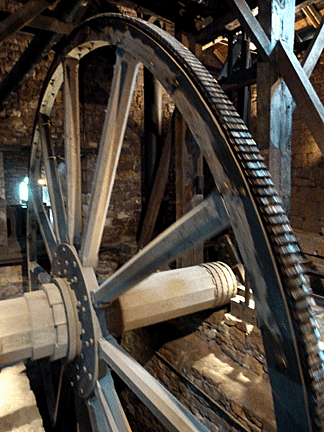 To
maintain intense furnace temperatures hot enough to melt rocks, it
was imperative to establish a steady stream of compressed air, or
blast. As the blast bubbled up through the burning mass in the
furnace, it fed oxygen to the fire, hastening the separation of the
iron from the ore.
To
maintain intense furnace temperatures hot enough to melt rocks, it
was imperative to establish a steady stream of compressed air, or
blast. As the blast bubbled up through the burning mass in the
furnace, it fed oxygen to the fire, hastening the separation of the
iron from the ore.
The first universal blast equipment was a water-powered bellows that
compressed the air and then fed it to the furnace through a pipe
called a tuyere. Soon pairs of closed blowing cylinders or blowing
tubs, still powered by water wheels, began to replace the old
leather bellows. The water wheel drove pistons up and down
reciprocally in the tubs, which had been lined with leather to make
them airtight. By a simple system of intake and exhaust valves, air
from the tubs was forced into a central mixing box and then through
a duct to the tuyere.
Blast operations became even more efficient in the 19th century as
water turbines and steam engines replaced the water wheels, which
enabled many furnaces to increase the number of tuyeres. In 1841,
the ironmaster installed a steam engine at Cornwall.
Furnace Operations
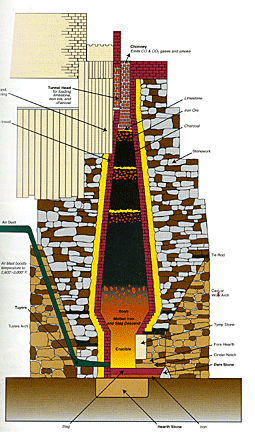 It
took two days to blow in, or start, a new furnace or to restart a
furnace that had blown out for repair or annual cleaning, a
necessary procedure that took six weeks to two months. Fillers
loaded charcoal into the tunnel head, or mouth of the furnace, until
the furnace was completely full. The charcoal was set on fire at the
top and allowed to burn all the way to the bottom. The fillers then
fed the furnace with charcoal until it was full again, this time
burning from the bottom until the stack was hot and nothing but
glowing coals remained.
It
took two days to blow in, or start, a new furnace or to restart a
furnace that had blown out for repair or annual cleaning, a
necessary procedure that took six weeks to two months. Fillers
loaded charcoal into the tunnel head, or mouth of the furnace, until
the furnace was completely full. The charcoal was set on fire at the
top and allowed to burn all the way to the bottom. The fillers then
fed the furnace with charcoal until it was full again, this time
burning from the bottom until the stack was hot and nothing but
glowing coals remained.
Then it was time to charge the furnace, adding alternate layers of
charcoal, iron ore, and limestone to the fiery mass at regular
intervals. Fillers charged the furnace day and night with the
proportions of these three materials as deter-mined by the founder
based on his basic analysis of the ore on hand. Charging continued
day and night for as long as the furnace was in blast, 18 to 20
charges a day. As the temperature approached 2500 to 3200 degrees F
in the bosh, the rocks began to melt and the furnace to work.
Workers removed the slag and discarded it every hour or half hour.
In this continuous process, it took
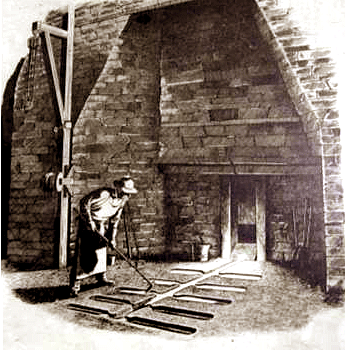 about
40 hours for a batch of iron ore to go from mouth to hearth.
about
40 hours for a batch of iron ore to go from mouth to hearth.
Twice a day, workers tapped the furnace. At about noon and midnight,
at the founder's signal, workers gathered in the casting house at
the bottom of the furnace stack. The keeper unplugged the cinder
notch, the top hole in the dam stone or door, which allowed the
remaining liquid slag to drain off to one side. After the slag
cooled, workers broke it up and discarded it. They then removed the
lower plug in the dam stone and red hot, molten iron flowed through
channels into the molds already prepared by the molders in the sand
floor of the cast house.
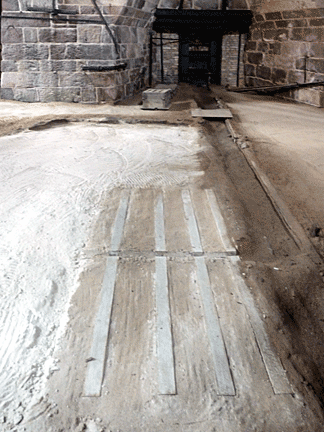 Guttermen
guided the flow from the large channel into the smaller molds formed
at right angles. This figure resembled a sow with nursing piglets,
so the main product of the blast furnace became known as pig iron.
Pigs, the first step in extracting iron from ore, had a flat side
and could be stored or transported to market or to the forge for
further refining.
Guttermen
guided the flow from the large channel into the smaller molds formed
at right angles. This figure resembled a sow with nursing piglets,
so the main product of the blast furnace became known as pig iron.
Pigs, the first step in extracting iron from ore, had a flat side
and could be stored or transported to market or to the forge for
further refining.
Workers in the casting house also cast some of the liquid iron as
ironware by molders, who ladled molten iron from the furnace into
special casting flasks to produce common items such as skillets,
kettles, and stove plates. Using skillfully carved molds, molders
often cast stove plates with intricate designs that included the
furnace and ironmaster's name, date of casting, Bible verses, and
other mottoes and symbols.
 The
Cornwall iron furnace remained in operation until 1883, when newer
furnace operations fueled by anthracite coal made it obsolete. The
abandoned furnace remained untouched until Margaret Coleman Freeman
Buckingham, the great-granddaughter of Robert Coleman,. donated it
to the state in 1932.
The
Cornwall iron furnace remained in operation until 1883, when newer
furnace operations fueled by anthracite coal made it obsolete. The
abandoned furnace remained untouched until Margaret Coleman Freeman
Buckingham, the great-granddaughter of Robert Coleman,. donated it
to the state in 1932.
Cornwall Iron Furnace Today
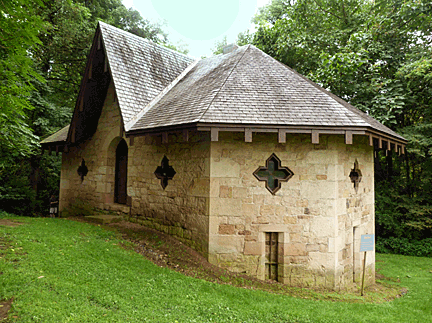 The
furnace site today includes remnants of the original 18th-century
industry—the19th-century furnace building and connecting shed, wagon
shop, and blacksmith shop, abattoir, and charcoal barn, as well as
stone coal bins and roasting oven. The former manager’s house and
office and stable are now occupied privately. The flooded open-pit
iron mine lies just up the road from the furnace and the former
ironmaster’s house is now the centerpiece of a retirement community
across the road.
The
furnace site today includes remnants of the original 18th-century
industry—the19th-century furnace building and connecting shed, wagon
shop, and blacksmith shop, abattoir, and charcoal barn, as well as
stone coal bins and roasting oven. The former manager’s house and
office and stable are now occupied privately. The flooded open-pit
iron mine lies just up the road from the furnace and the former
ironmaster’s house is now the centerpiece of a retirement community
across the road.
